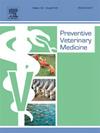丹麦畜群的母猪死亡率。生产系统之间的差异、年度和季节性趋势以及与畜群规模的关系
IF 2.4
2区 农林科学
Q1 VETERINARY SCIENCES
引用次数: 0
摘要
猪舍和管理可能对母猪死亡率有影响。因此,仔细研究在这些参数上明显不同的系统之间死亡率的差异是有意义的。在这项研究中,我们使用丹麦国家数据库提取2015-22年期间所有有机和传统母猪群的数据,以模拟传统和有机系统的死亡率。此外,我们利用温度数据调查了两个系统中夏季和温度对母猪死亡率的潜在关联。最后,对于传统系统,我们调查了与群体规模的潜在关联。在这两个系统中,我们看到了不同畜群之间死亡率的显著差异。在研究期间的头四年,这两个系统的死亡率相似——每年约有10% %的母猪死亡。从2018年起,传统畜群的死亡率增加,到2022年平均达到14.4% %。在该系统中,我们发现畜群规模与母猪死亡率呈正相关。在整个研究期间,有机畜群的死亡率保持在10% %。在这两个系统中,死亡率在夏季都较高,但只有有机系统的死亡率似乎与高温有关。我们的研究结果表明,母猪死亡率与管理和住房因素有关。他们证实,夏季母猪死亡率略高,但指出,除了高温之外,其他因素似乎也会影响母猪死亡率,尤其是在传统猪群中。本文章由计算机程序翻译,如有差异,请以英文原文为准。
Sow mortality in Danish herds – Differences between production systems, annual and seasonal trends and association to herd sizes
Housing and management are likely to play a role in sow mortality. Therefore, it is of interest to scrutinize differences in mortality rates between systems that are markedly different on these parameters. In this study, we used Danish national databases to extract data from all organic and conventional sow herds in the period 2015–22 to model mortality rates in conventional and organic systems. Furthermore, we used temperature data to investigate potential associations between summer season and temperatures on sow mortality in each of the two systems. Finally, for the conventional system we investigated potential associations with herd size. In both systems we saw a marked variability in mortality rates between herds. During the first four years of the study period mortality rates in the two systems were similar - approximately 10 % of sows died per year. From 2018 and onwards, mortality rates in conventional herds increased and reached an average of 14.4 % in 2022. In this system, we found a positive correlation between herd size and sow mortality. In organic herds, the mortality rate stayed at 10 % throughout the study period. In both systems, mortality rates were higher in the summer months, but only in the organic system the increase seemed to be associated with high temperatures. Our results indicate that sow mortality is associated with management and housing factors. They confirm that sow mortality is slightly higher in the summer months but point out that other factors than high temperatures seem to impact the sow mortality, especially in conventional herds.
求助全文
通过发布文献求助,成功后即可免费获取论文全文。
去求助
来源期刊

Preventive veterinary medicine
农林科学-兽医学
CiteScore
5.60
自引率
7.70%
发文量
184
审稿时长
3 months
期刊介绍:
Preventive Veterinary Medicine is one of the leading international resources for scientific reports on animal health programs and preventive veterinary medicine. The journal follows the guidelines for standardizing and strengthening the reporting of biomedical research which are available from the CONSORT, MOOSE, PRISMA, REFLECT, STARD, and STROBE statements. The journal focuses on:
Epidemiology of health events relevant to domestic and wild animals;
Economic impacts of epidemic and endemic animal and zoonotic diseases;
Latest methods and approaches in veterinary epidemiology;
Disease and infection control or eradication measures;
The "One Health" concept and the relationships between veterinary medicine, human health, animal-production systems, and the environment;
Development of new techniques in surveillance systems and diagnosis;
Evaluation and control of diseases in animal populations.
 求助内容:
求助内容: 应助结果提醒方式:
应助结果提醒方式:


